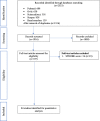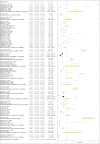Prevalence and risk factors of gestational diabetes mellitus in Asia: a systematic review and meta-analysis
- PMID: 30547769
- PMCID: PMC6295048
- DOI: 10.1186/s12884-018-2131-4
Prevalence and risk factors of gestational diabetes mellitus in Asia: a systematic review and meta-analysis
Abstract
Background: Gestational diabetes mellitus (GDM) is a of the major public health issues in Asia. The present study aimed to determine the prevalence of, and risk factors for GDM in Asia via a systematic review and meta-analysis.
Methods: We systematically searched PubMed, Ovid, Scopus and ScienceDirect for observational studies in Asia from inception to August 2017. We selected cross sectional studies reporting the prevalence and risk factors for GDM. A random effects model was used to estimate the pooled prevalence of GDM and odds ratio (OR) with 95% confidence interval (CI).
Results: Eighty-four studies with STROBE score ≥ 14 were included in our analysis. The pooled prevalence of GDM in Asia was 11.5% (95% CI 10.9-12.1). There was considerable heterogeneity (I2 > 95%) in the prevalence of GDM in Asia, which is likely due to differences in diagnostic criteria, screening methods and study setting. Meta-analysis demonstrated that the risk factors of GDM include history of previous GDM (OR 8.42, 95% CI 5.35-13.23); macrosomia (OR 4.41, 95% CI 3.09-6.31); and congenital anomalies (OR 4.25, 95% CI 1.52-11.88). Other risk factors include a BMI ≥25 kg/m2 (OR 3.27, 95% CI 2.81-3.80); pregnancy-induced hypertension (OR 3.20, 95% CI 2.19-4.68); family history of diabetes (OR 2.77, 2.22-3.47); history of stillbirth (OR 2.39, 95% CI 1.68-3.40); polycystic ovary syndrome (OR 2.33, 95% CI1.72-3.17); history of abortion (OR 2.25, 95% CI 1.54-3.29); age ≥ 25 (OR 2.17, 95% CI 1.96-2.41); multiparity ≥2 (OR 1.37, 95% CI 1.24-1.52); and history of preterm delivery (OR 1.93, 95% CI 1.21-3.07).
Conclusion: We found a high prevalence of GDM among the Asian population. Asian women with common risk factors especially among those with history of previous GDM, congenital anomalies or macrosomia should receive additional attention from physician as high-risk cases for GDM in pregnancy.
Trial registration: PROSPERO (2017: CRD42017070104 ).
Keywords: Asia; meta-analysis; Gestational diabetes mellitus; Prevalence; Risk factors.
Conflict of interest statement
Ethics approval and consent to participate
This article contains only studies that comply with ethical standards. All of the eligible articles included in the meta-analysis stated that they had obtained informed consent from participants.
Consent for publication
Not applicable.
Competing interests
The authors declare that they have no competing interests.
Publisher’s Note
Springer Nature remains neutral with regard to jurisdictional claims in published maps and institutional affiliations.
Figures
References
-
- Metzger BE, Coustan DR, Committee O Summary and recommendations of the fourth international workshop-conference on gestational diabetes mellitus. Diabetes Care. 1998;21:B161. - PubMed
-
- Wendland EM, Torloni MR, Falavigna M, Trujillo J, Dode MA, Campos MA, et al. Gestational diabetes and pregnancy outcomes-a systematic review of the World Health Organization (WHO) and the International Association of Diabetes in Pregnancy study groups (IADPSG) diagnostic criteria. BMC Pregnancy Childbirth. 2012;12(1):23. doi: 10.1186/1471-2393-12-23. - DOI - PMC - PubMed
Publication types
MeSH terms
Grants and funding
- UPM/700-2/1/GP-IPS/2018/9593800/Fakulti Perubatan dan Sains Kesihatan, Universiti Putra Malaysia
- (UPM/800-3/3/1/GPB/2018/9659600)/Fakulti Perubatan dan Sains Kesihatan, Universiti Putra Malaysia
- Graduate Research Fellowship (UPM/SPS/GS48750)./Fakulti Perubatan dan Sains Kesihatan, Universiti Putra Malaysia
LinkOut - more resources
Full Text Sources
Medical



